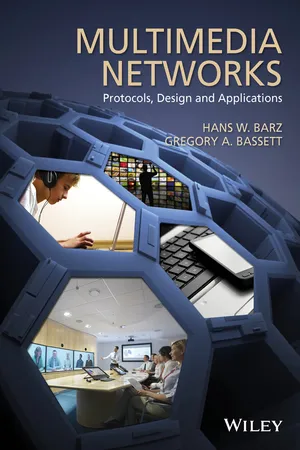This book is aimed for students and practitioners with a basic knowledge in computer networks. One possible source on the basics of computer networks is the book by Tanenbaum and Wetherall [1].
We will provide the reader with all concepts of currently used Internet Protocol (IP) technologies to deliver multimedia efficiently to the user. The book does not treat any non-IP multimedia technologies – for example, TV/Audio transmission by satellite, cable, or other terrestrial methods. For examples of these technologies, see Ref. [2].
We provide enough detail to understand the operation and transmission of multimedia data over a packet network. However, it is not intended to provide sufficient detail for an implementation of a complete multimedia application. For that level of detail, we provide links to the relevant standards and other literature.
The transport of multimedia over the network requires timely and errorless transmission much more strictly than any other data. The criticality of transport has led to specialized protocols and to special treatment within multimedia applications (telephone, IP-TV, streaming, and others) to overcome network issues.
The percentage of multimedia traffic over the Internet is already substantial today and, based on 2014 estimations, will grow to 79% of all traffic by 2018. Therefore, the knowledge of protocols used and handling of the traffic needs to increase as well.
The next chapter will exemplify the typical requirements of multimedia applications, and we will show their protocols and implementation in later chapters.
Before we treat the underlying network functions in Chapter 4 and synchronization in Chapter 5, we will treat coding and compression of multimedia in Chapter 3. At first glance, the need for the treatment of coding and compression may not be obvious, since in computer networking, one typically assumes that the lower layers are independent of the application layers. However, experienced networkers know that even data-driven applications occasionally show unacceptably long response times over Wide Area Networks (WANs). In such situations, network and application engineers jointly analyze this in network labs, and after that, the application and/or network gets changed. Multimedia applications require an absolutely optimal interworking with the network since it cannot afford response time variations of a second as a data-driven application. This optimization requires knowledge of what options are possible on both sides. Consequently, we have to treat coding and compression for multimedia in Chapter 3.
While the next chapters handle technologies, we also have to understand how multimedia fit into existing network types, which standard organizations are creating the specifications, and how the market functions. These elements strongly influence the real use of multimedia.
1.1 Types of Networks
We will classify networks according to the following types: Internet, Telecommunication providers, Companies, Universities, and Home. It will become obvious that certain multimedia applications only work well in certain network types. Each network type is characterized by the following elements:
- Administration: Organization of the administration
- Redundancy/stability: Network is constructed to fulfill certain stability goals
- Service quality: Availability of service classes guaranteeing traffic quality
- Monitoring: Extent of network monitoring
- Standards: Standards on which the network is based
- Operator: Who operates the network.
1.1.1 Internet
The Internet has central bodies for standardization – Internet Engineering Task Force (IETF) – and addressing – Internet Corporation for Assigned Names and Numbers (ICANN). However, the Internet has no central administration that rules all interconnection and technical implementation details. The Internet offers a lot of redundancies, but there is no authority that plans this in detail. Service qualities do not exist and cannot be contracted. The network is monitored in parts but not as a whole.
The standards of the IETF govern all traffic and protocols. In some locations, additional protocols may work, but this is not true globally.
A plethora of telecommunication providers and institutions operate the Internet.
1.1.2 Telecommunication Provider Networks
Each telecommunication service provider (Telco) has a home territory where he owns cable infrastructure. Historically, each country has one major network provider who had once the monopoly for all telecommunication services within the country (incumbent). With the exception of the United States, the incumbents still own the majority of all cable infrastructure within their home country and typically all connections to the households. The particular situation in the United States slows the implementation of High-End TV as presented in Chapter 11.
Major Telcos contract network links or network capacity from other Telcos and build international cable infrastructure jointly in consortiums. The biggest Telcos of the world are American Telephone and Telegraph (AT&T, United States), Verizon (United States), British Telecom (BT, United Kingdom), Orange (France), German Telekom, Nippon Telegraph and Telephone Corporation (NTT, Japan), Telefonica (Spain), and Colt (United Kingdom).
Each Telco's network is centrally administered, and all redundancy is centrally planned. The network is monitored with the exception of links to the households. Service quality can also be provided at additional cost over contracted links in other countries. The Telcos offer services to their clients (companies, universities, end users, other providers) in different quality and throughput levels:
- Pure connectivity – that is, a link or part of a link with given throughput – based upon IEEE (International Electrical and Electronics Engineers) standards
- Data traffic based upon I...
